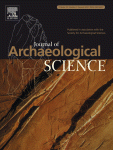| New Volume/Issue is now available on ScienceDirect |
| | Original Research Articles | |
| | 2. | Petrography as a technique for investigating Iroquoian ceramic production and smoking rituals Original Research Article
Pages 1-10
Gregory V. Braun
Highlights► Petrographic analysis of Middle Iroquoian smoking pipes and pottery containers. ► Variation in pipes much greater than that seen in pottery. ► Pottery made by small group of people for the community, pipes made by individuals. ► Raw materials for pots and pipes were chosen for their symbolic value. ► May indicate changes in shamanistic practices and smoking rituals.
| |
| | 7. | Lead isotope analysis as a new method for identifying material culture belonging to the Vázquez de Coronado expedition Original Research Article
Pages 58-66
Alyson M. Thibodeau, John T. Chesley, Joaquin Ruiz
Highlights► Recognizing artifacts from the Vázquez de Coronado expedition is a challenge. ► Measured lead isotopic ratios of metals from two sites associated with the expedition. ► When compared, artifacts from both sites share a specific lead isotopic fingerprint. ► Lead isotopes can help identify artifacts tied to the Coronado expedition. ► Expedition’s supply of lead and copper metal likely came from Mexican ores.
| |
| | 10. | Cattle in the West African savanna: evidence from 1st millennium CE Kirikongo, Burkina Faso Original Research Article
Pages 92-101
Stephen A. Dueppen
Highlights► West Africa is home to diverse cattle adapted to their environments. ► Measurements on archaeological specimens are used to distinguish cattle size groups. ► Cattle from Iron Age Kirikongo are likely ancestral to West African Shorthorn. ► West African Shorthorn distributions have shifted with environmental change. ► Interregional interactions can be identified using domestic animal adoption events.
| |
| | 12. | Charcoal scarcity in Epigravettian settlements with mammoth bone dwellings: the taphonomic evidence from Mezhyrich (Ukraine) Original Research Article
Pages 109-120
L. Marquer, V. Lebreton, T. Otto, H. Valladas, P. Haesaerts, E. Messager, D. Nuzhnyi, S. Péan
Highlights► We discuss the burnt bone abundances and the wood charcoal absences in hearths. ► We examine the sediments of Mezhyrich Epigravettian site until microscopic scales. ► We recovered a significant amount of wood charcoals which provides radiocarbon dates. ► Charcoal scarcity was due to an important mass reduction and fragmentation processes. ► Charcoal data indicate the presence of forest patches in a mammoth steppe landscape.
| |
| | 13. | Osteometric and molecular sexing of cattle metapodia Original Research Article
Pages 121-127
Y. Telldahl, E.M. Svensson, A. Götherström, J. Storå
Highlights► The results show that osteometrical measurements for cattle metapodials could be used for sexing. ► The molecular and morphological analyses show that cattle metatarsals exhibit a sexual dimorphism for several measurements. ► Despite distal broadening of medial trochlea the Bcr-measurement showed “correct” values.
| |
| | 15. | Crystallographic and structural transformations of sedimentary chalcedony in flint upon heat treatment Original Research Article
Pages 135-144
Patrick Schmidt, Sylvie Masse, Guillaume Laurent, Aneta Slodczyk, Eric Le Bourhis, Christian Perrenoud, Jacques Livage, François Fröhlich
Highlights► The major transformation to happen is the loss of SiOH and the creation of new Si–O–Si bonds (Si‑OH HO–Si→Si–O–Si+H2O). ► This reaction starts between 200°C and 300°C. ► The maximal annealing temperature and the ramp rate depend on the size of the specimen and the volume of its porosity. ► The annealing duration can be relatively short (<50min).
| |
| | 17. | Chronology during the Bronze Age in the archaeological site Tell Qubr Abu al-‘Atiq, Syria Original Research Article
Pages 163-174
Jorge Sanjurjo-Sánchez, Juan Luis Montero Fenollós
Highlights► The OSL of muddy archaeosediments in Meopotamia have been little studied up to now. ► The site Tell Qubr Abu al-’Atiq, a Bronze Age site has been dated by OSL, TL and14C. ► It was occupied during Early Bronze (2840–2340yr BC) and Late Bronze (900–1300yr BC). ► OSL of sediments shows ages younger than charcoal and pottery. ► Pottery and charcoal dates occupation events while sediments date destruction events.
| |
| | 18. | A radiocarbon chronology for the complete Middle to Upper Palaeolithic transitional sequence of Les Cottés (France) Original Research Article
Pages 175-183
Sahra Talamo, Marie Soressi, Morgan Roussel, Mike Richards, Jean-Jacques Hublin
Highlights► Les Cottés is one of the rare sites with a complete sequence covering the Middle to Upper Palaeolithic transition period. ► Based on 27 AMS mammal bone we constructed a chronological framework from the Mousterian to the Early Aurignacian. ► Mousterian and Châtelperronian industries are separated from the overlying Protoaurignacian by a gap of approximately 1000 calendar years. ► The Proto and Early Aurignacian appear contemporaneous. ► Anatomically Modern Humans are present at the site at least at 39,500 cal BP roughly coincident Heinrich event 4.
| |
| | 19. | Palaeolithic dog skulls at the Gravettian Předmostí site, the Czech Republic Original Research Article
Pages 184-202
Mietje Germonpré, Martina Lázničková-Galetová, Mikhail V. Sablin
Highlights► Accepting an Aurignacian beginning of the domestication of the wolf is controversial. ►The Gravettian canid skulls from Předmostí were studied to check for the presence of dogs. ►Ancient dogs are characterized by short skulls and snouts, and wide palates and braincases. ►Using these criteria three Předmostí skulls were singled out as Gravettian dogs. ►Human modifications of the skulls hint at a specific human/large canid relationship.
| |

Núcleo de Arqueologia e Paleoecologia Laboratório G22 FCHS - Departamento de História, Arqueologia e Património Universidade do Algarve Campus de Gambelas 8005-139 Faro, PORTUGAL Mail: nap.ualg@gmail.comUrl: http://nap-ualg.blogspot.com
|




